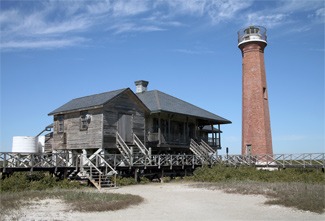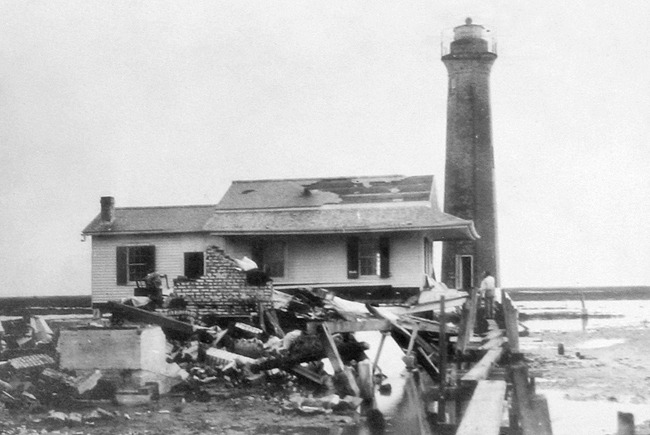Only a few gaps or passes that give access to safe bays and harbors break up the 400-mile-long barrier island and peninsula chain that protects Texas’ coastline. One such chasm in Aransas Pass is between Mustang Island and Saint Joseph Island to the south. About twenty miles to the west of the pass is the port of Corpus Christi.
Congress approved $12,500 on March 3, 1851, to build the Aransas Pass Lighthouse. While charting this section of the Texas coast in the same year, Lieutenant Commander T.A. Craven of the Coast Survey suggested that a lightship be used to mark the pass, which was known to be gradually moving south as currents cut away the northern tip of Mustang Island and deposited sand on Saint Joseph Island’s southern end.
Contributing Personalities to the Lighthouse’s Progress
1. Lighthouse Board commissioned a second examination of the coast in 1853. H.S. District Inspector Walter H. Stevens in Galvenston recommended a prefabricated cast-iron tower like Bolivar Point and Matagorda Island. Stellwagen concluded that a screw-pile lighthouse inside the pass would be useful. Just inside the pass, on Harbor Island, the federal government acquired twenty-five acres, and on June 20, 1855, the state of Texas relinquished control of the property.
2. In December 1855, a schooner carrying the tower’s bricks collapsed on a sandbar at the Aransas Pass destroying its cargo, but the crew was saved. A lantern room and a fourth-order Fresnel lens arrived on the island in 1856 and in 1857 the brown octagonal tower was finished. Later that year, the lantern room first illuminated the night sky above the pass.
3. After the Civil War ended the lens was taken out of the lantern room. Confederate and Union armies exchanged control over the tower which was to be destroyed on Christmas Day 1862 by Confederate General John B. Magruder.
4. In 1867, a construction team arrived to fix the damaged tower’s upper section but was delayed by a winter storm described as “one of the severest Northers ever experienced on the Texas coast” by Acting District Lighthouse Engineer M.F. Bonzano.
5. On June 3, 1869, Parry W. Humphreys was chosen to be the lighthouse keeper. The family kept a garden on Mustang Island to supplement the food provided by the Lighthouse Service. Keeper Humphreys stayed at the station for more than sixteen years, although the two keepers before him left after only one year each. When Keeper Humphreys was about seventy-four years old in 1885, the District Inspector believed he was unsuitable to keep the station. The Humphreys eventually left the station in March 1886 when the superintendent arrived and encouraged Humphreys’ dismissal for “drunkenness, disobedience of commands, and refusing to pay his obligations” in addition to his age.
About thirty feet southwest of the lighthouse, a two-story hollow-tile structure was constructed on top of twenty cast-iron columns, each of which was supported by a concrete footing. The concrete footings capped a 19-foot yellow pine pile dug into the marsh. The house comprised two flats with three rooms each, and its roof overhung a wraparound porch. The residence had detached kitchens erected behind it, connected to it by a covered gallery that was four feet wide. A two-compartment frame toilet with a brick foundation and a creosoted pile foundation served as the facilities, which were also separate from the home. The residence was connected to the wharf by a five-foot-wide boardwalk that was around 270 feet long and thirty feet wide, built parallel to the neighboring creek.
Two days after the new structures were essentially finished, on September 13, 1919, a destructive hurricane once again hit the station. The new hollow-tile keeper’s residence provided shelter for the workers throughout the storm, while the previous assistant’s residence was destroyed. The double-dwelling was later joined by a smaller structure that was constructed directly behind the tower. Along with a third house that was erected around 1940, these buildings are still standing today.
By the middle of the 20th century, Aransas Pass had slowly gotten closer to the lighthouse—by more than a mile. In 1952, a new light was installed at the Port Aransas Coast Guard Station to better designate the entrance, and the Aransas Pass Lighthouse, which had served the community for less than a century, was shut down. With the Lydia Ann Channel now being the nearest waterway to the tower (it runs north from the pass), the lighthouse began to be referred to as the Lydia Ann Light.
The name Lydia Ann’s origin is a bit confusing. Keeper Frank Stephenson did have a daughter called Lydia Ann, who married her father’s helper, Thomas P. Roberts, but Stephenson was the station’s ninth keeper, not the first. The channel was “named for the daughter of the first keeper,” according to a historical sign close to the tower. According to local historians, Lydia Ann Dana Hastings Hull Wells, the wife of Texas Revolutionary War hero James B. Wells, who resided on St. Joseph Island with his family and kept cattle there for many years before passing away in 1880, is the inspiration behind the name of Lydia Ann Channel.
Conclusion
The lighthouse serves as a reminder of the historical significance of lighthouses, which were used to safely guide ships through the dangerous waters of the Gulf of Mexico. The Lydia Ann Channel Lighthouse serves as a reminder of the love and dedication it took to build and maintain the lighthouse, as well as the value of maintaining our nautical heritage.



